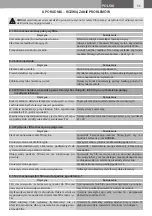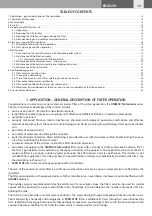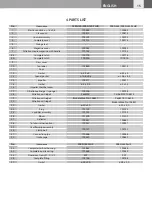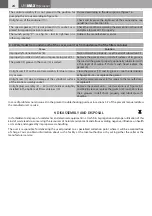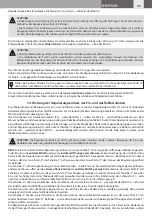
18
UNI
MAX
Professional
Fig. 15.
The figure shows the
layout of intake and outlet elements
from the inside of the aquarium:
On the end of intake canal an intake cage (32) is installed.
On the end of the outlet canal an intake strainer (28) is “
temporarily
” installed. *Why “temporarily”? Find the explanation
below:
During the automatic priming the filter with water drawn in from the aquarium (the operation is described in subsection 6.1),
the water can enter the filter not only through intake conduit but also through outlet conduit. Therefore when assembling the
temporary layout it is important that:
•
the ends of both canals are submerged as deep as possible in the water
•
the ends of both pipes have to be closed with strainers – e.g. parts (28) and (32), otherwise small fish can be sucked
into the filter.
6. START-UP, USAGE AND FILTER REGULATION
After completing all of the preparation actions described in section 5, if the aquarium is empty, it should be filled with
water to the highest possible level.
6.1. Priming the filter and other preparations
Fig. 16.
Turn the control assembly (3) in the cover (4) anticlockwise
until resistance
, into position marked on the figure,
according to arrow I. In this position both the intake and the outlet are closed.
Remove part of the air from the filter by using the pump “P” with over ten vigorous moves according to arrow II. The pump
should be left in the bottom position – later it will not interfere.
Immediately after completing the above actions, move the control assembly (3) to its starting position (e.g. shown on
the figure 13). Now thanks to the underpressure in the container, automatic priming process will begin. In the first phase
the process may proceed slowly, but eventually it should lead to filling the filter with water.
If – due to little number of pumping movements, too low water level or a delay in turning the control assembly – auto-
matic filter priming will not occur, the aquarium should be filled with water to the highest possible level and the above
operation repeated increasing the number and vigor of movements and after completing the pumping move back the
control assembly (3) vigorously,
right away and without any delay
.
After priming the filter, replenish the water in the aquarium.
Fig. 17.
Remove and put aside for any future start-ups – the terminal elements of temporary outlet system (31 and 28),
that were installed according to figure 15 only for the purpose of effecting the automatic filling the filter with water. Now
the
target outlet elements
can be assembled. On the present figure two alternatives are presented. Using the supplied
elements the system can be adapted to the shape of a specific aquarium. If the sprinkler (25) will be used, it is recom-
mended to install it above the water level so that it will effectively aerate the water in the aquarium. It is recommended
to direct the water stream going through the deflector (27) towards a heater or sensor of a thermo regulator.
6.2. Start-up, usage and filter regulation
After completing all of the preparations described above the filter is ready to be launched. The filter pump is started by
placing into electric socket the plug of the power cord emerging from the filter cover (4). After turning on the pump the
remnants of the air from inside of the filter will be removed. The filter deaerates itself automatically.
After launching the filter verify the whole system tightness.
The control assembly after launching (3) is in its basic position shown on figure 13 and the filter works with maximum
output. If there is such need – e.g. in case of using the filter for smaller aquarium, the filter output can be adjusted by
turning the control assembly (3) anticlockwise, according to arrow “I” on the figure 16 (in the terminal position of the
control assembly shown on figure 16, the filter output is reduced to zero).
After the water flow in the filter is stabilized, the UV sterilizer can be turned on – by putting the plug ballast into electric
socket (applies to
FZKN PLUS
types and the filters with user installed sterilizer according to subsection 5.2). On the
ballast a lamp signalizing the UV sterilizer operation will immediately light up. The sterilizer work cycle should be estab-
lished experimentally, initially operating for several hours a week. After the lapse of the planned period of operation the
sterilizer should be turned off by removing the plug ballast from the socket.
CAUTION:
Do not cover the plug ballast of UV sterilizer.
Summary of Contents for UNIMAX PROFESSIONAL FZKN 150
Page 3: ...b a UNIMAX Professional FZKN 150 PLUS FZKN 250 PLUS...
Page 4: ...b a b...
Page 5: ......
Page 6: ...b a UNIMAX Professional FZKN 150 FZKN 250...
Page 89: ...83 8 8 1 5 8 8 2 4 7 3 8 3 15 21 16 21 22 8 4 AQUAEL 7 2 7 3...
Page 101: ...95 8 UV c 8 1 5 8 8 2 4 7 3 8 3 15 21 16 21 22 8 4 AQUAEL 7 2 7 3...








